WEE Technology Company Limited - WEE are Capacitors Specialist
The ceramic resistors are an affordable resistor for budget to medium quality audio application and a proven stable of the OEM speaker manufacturing industry
Small in dimensions, excellent in stability with high tolerance for temperature, humidity, and shock
• Resistance tolerance: 5%
• Completely insulated making them highly suitable for PCB crossover application
• In the high values the winding cores are replaced by high power handling film
• Instant overload capacity, low noise figure and low annual shift in resistance value
• Max overload voltage is 2 times of max. working voltage
• Power handling film means that decreasing the resistance values compared to models with wound resistance wire
• Dimensions for 5 watt Ceramic: 23 mm/ 10 mm / 10 mm
• Dimensions for 10 watt Ceramic: 48 mm/ 10 mm / 10 mm
• Dimensions for 20 watt Ceramic: 61 mm/ 15 mm / 15 mm
https://www.weetcap.com/Resistors/WEET-SQP-Series-Axial-Cement-Ceramic-Resistor.html
| Ceramic Audio Resistors | |||||
| Watt | R [Ω] | Watt | R [Ω] | Watt | R [Ω] |
| 5W | 0.10 | 10W | 0.10 | 20W | 0.47 |
| 5W | 0.22 | 10W | 0.22 | 20W | 0.56 |
| 5W | 0.27 | 10W | 0.27 | 20W | 0.62 |
| 5W | 0.33 | 10W | 0.33 | 20W | 0.68 |
| 5W | 0.36 | 10W | 0.39 | 20W | 0.75 |
| 5W | 0.39 | 10W | 0.43 | 20W | 0.82 |
| 5W | 0.43 | 10W | 0.47 | 20W | 0.91 |
| 5W | 0.47 | 10W | 0.51 | 20W | 1.00 |
| 5W | 0.51 | 10W | 0.56 | 20W | 1.10 |
| 5W | 0.56 | 10W | 0.62 | 20W | 1.20 |
| 5W | 0.62 | 10W | 0.68 | 20W | 1.30 |
| 5W | 0.68 | 10W | 0.75 | 20W | 1.50 |
| 5W | 0.75 | 10W | 0.82 | 20W | 1.60 |
| 5W | 0.82 | 10W | 0.91 | 20W | 1.80 |
| 5W | 0.91 | 10W | 1.00 | 20W | 2.00 |
| 5W | 1.00 | 10W | 1.10 | 20W | 2.20 |
| 5W | 1.10 | 10W | 1.20 | 20W | 2.40 |
| 5W | 1.20 | 10W | 1.30 | 20W | 2.70 |
| 5W | 1.30 | 10W | 1.50 | 20W | 3.00 |
| 5W | 1.50 | 10W | 1.60 | 20W | 3.30 |
| 5W | 1.60 | 10W | 1.80 | 20W | 3.60 |
| 5W | 1.80 | 10W | 2.00 | 20W | 3.90 |
| 5W | 2.00 | 10W | 2.20 | 20W | 4.30 |
| 5W | 2.20 | 10W | 2.40 | 20W | 4.70 |
| 5W | 2.40 | 10W | 2.70 | 20W | 5.10 |
| 5W | 2.70 | 10W | 3.00 | 20W | 5.60 |
| 5W | 3.00 | 10W | 3.30 | 20W | 6.20 |
| 5W | 3.30 | 10W | 3.60 | 20W | 6.80 |
| 5W | 3.60 | 10W | 3.90 | 20W | 7.50 |
| 5W | 3.90 | 10W | 4.30 | 20W | 8.20 |
| 5W | 4.30 | 10W | 4.70 | 20W | 9.10 |
| 5W | 4.70 | 10W | 5.10 | 20W | 10.00 |
| 5W | 5.10 | 10W | 5.60 | 20W | 12.00 |
| 5W | 5.60 | 10W | 6.20 | 20W | 15.00 |
| 5W | 6.20 | 10W | 6.80 | 20W | 18.00 |
| 5W | 6.80 | 10W | 7.50 | 20W | 22.00 |
| 5W | 7.50 | 10W | 8.20 | 20W | 27.00 |
| 5W | 8.20 | 10W | 9.10 | 20W | 33.00 |
| 5W | 9.10 | 10W | 10.00 | 20W | 36.00 |
| 5W | 10.00 | 10W | 12.00 | 20W | 39.00 |
| 5W | 12.00 | 10W | 15.00 | 20W | 43.00 |
| 5W | 15.00 | 10W | 18.00 | 20W | 47.00 |
| 5W | 18.00 | 10W | 22.00 | 20W | 51.00 |
| 5W | 22.00 | 10W | 27.00 | 20W | 56.00 |
| 5W | 27.00 | 10W | 33.00 | 20W | 62.00 |
| 5W | 33.00 | 10W | 36.00 | 20W | 68.00 |
| 5W | 36.00 | 10W | 39.00 | 20W | 75.00 |
| 5W | 39.00 | 10W | 43.00 | 20W | 82.00 |
| 5W | 43.00 | 10W | 47.00 | 20W | 91.00 |
| 5W | 47.00 | 10W | 51.00 | 20W | 100.00 |
| 5W | 51.00 | 10W | 56.00 | 20W | 150.00 |
| 5W | 56.00 | 10W | 62.00 | 20W | 220.00 |
| 5W | 62.00 | 10W | 68.00 | ||
| 5W | 68.00 | 10W | 75.00 | ||
| 5W | 75.00 | 10W | 82.00 | ||
| 5W | 82.00 | 10W | 91.00 | ||
| 5W | 100.00 | 10W | 100.00 | ||
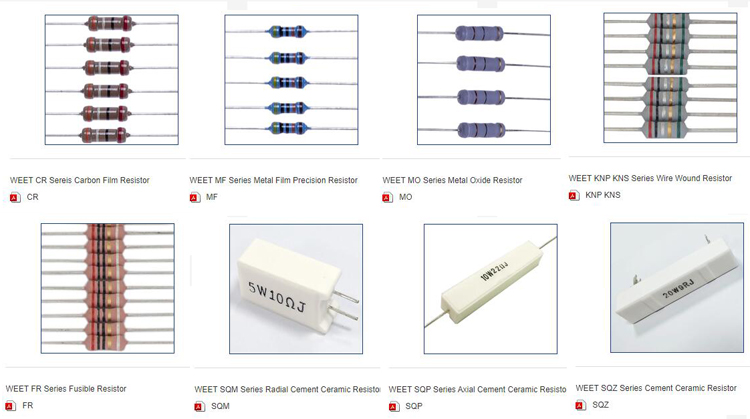
WEE Technology Company Limited - WEE are Capacitors Specialist
In the past, the most commonly used thin-film capacitors were CBB22 capacitor and CL21 capacitor. Among them, CL21 capacitor was largely replaced by CBB22 capacitor, and the frequency of CL21 capacitor was less and less. However, now there is a CL21X capacitor, which has become particularly large. What is CL21X capacitor? What are its characteristics and functions?
CL21X subminiature polyester film capacitor
The full name of CL21x capacitor is metallized polyester film subminiature capacitor. We know that the biggest advantage of CL capacitor compared with CBB capacitor is smaller volume and higher temperature resistance. Therefore, polyester film is often selected when making subminiature capacitor, which can make the capacitor volume smaller. This is also one reason why CL21X capacitor has more users.
Structure of CL21X capacitor
Medium: polyester film
Electrode: metal vacuum evaporation layer (aluminum)
Package: flame retardant epoxy resin (UL94 V-0)
Lead: tinned copper-clad steel wire (CP wire) or tinned copper wire
Characteristics and functions of CL21X capacitor
The volume of CL21X capacitor is very small and has good self-healing; Good appearance consistency; High reliability.
It is mostly used in DC and low pulse occasions. Such as low-frequency filtering, DC isolation, bypass and coupling, etc.
Check more details at : https://www.weetcap.com/Plastic-Film-Capacitors/WEET-WFH-CL21X-Mini-Metallized-Polyester-Film-Capacitor.html
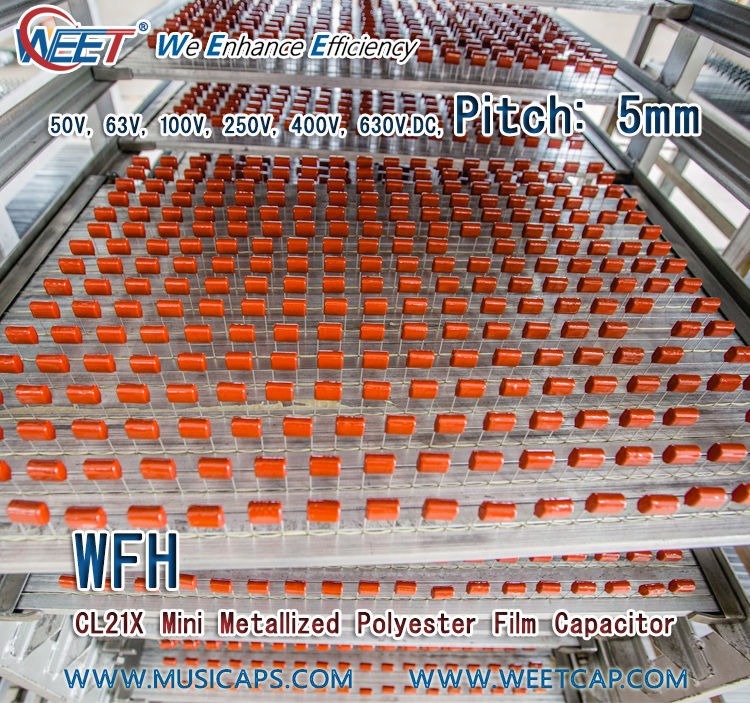
WEE Technology Company Limited - WEE are Capacitors Specialist
What is the difference between CL71 and CL23B
1. CL71 is a correction capacitor of laminated structure.
CL71 is indeed a correction capacitor, but it belongs to the internal structure and is laminated. In fact, CL23B and CL71 belong to non inductive winding, but CL71 capacitor basically has no inductance, while CL23B has a small amount of inductance. However, the disadvantage of CL71 capacitor is that the production is complex and the production equipment is very expensive. At present, it is very rare for domestic manufacturers to produce CL71 capacitor.
2. CL23B is a winding correction capacitor.
The correction capacitors we see on the market are basically CL23B metallized polyester film wound capacitors. They belong to ultra-small polyester film capacitors, also known as minbox capacitors. It is much less difficult to produce. Most manufacturers who are good at producing small film capacitors can produce them, and the equipment used is relatively common.
Small boxed film capacitors CL23B series use metallized polyethylene film as medium and electrode, non inductive winding structure, encapsulated in small plastic shell and filled with epoxy resin. CL23B series correction capacitors are suitable for various applications of MEF series, especially those with high requirements for capacitor size and square appearance.
Characteristics and functions of CL23B correction capacitor: small volume, light weight, wide capacity range and large ratio capacity; Good self-healing and long service life; Applicable to DC isolation, bypass, coupling and filtering of DC and VHF signals; It is especially suitable for color TV, SPC exchange and military machine LCD monitor rectification, automotive DC motor interference suppression and other occasion
https://www.weetcap.com/Plastic-Film-Capacitors/
WFG CL23B Mini Box Metallized Polyester Film Capacitor Standard Capacitance, voltage and size table.
For other values, please contact with our sales for more details.
| CODE | UF | 63V | 100V | 250VDC | 400VDC | 630VDC | (W*H*T) |
| 102 | 0.001 | M1 | M1 | M1,M2 | M2,M3 | M2,M3 | M1:7.2*6.5*2.5 |
| 152 | 0.0015 | M1 | M1 | M1,M2 | M2,M3 | M2,M3 | M2:7.2*7.5*3.5 |
| 222 | 0.0022 | M1 | M1 | M1,M2 | M2,M3 | M2,M3 | M3:7.2*9.5*4.5 |
| 332 | 0.0033 | M1 | M1 | M1,M2 | M2,M3 | M2,M3 | M4:7.2*10*5 |
| 472 | 0.0047 | M1 | M1 | M1,M2 | M2,M3 | M2,M3 | M5:7.2*11*6 |
| 682 | 0.0068 | M1 | M1 | M1,M2 | M2,M3 | M2,M3 | |
| 103 | 0.01 | M1 | M1 | M1,M2 | M2,M3 | M3 | |
| 153 | 0.015 | M1 | M1 | M1,M2 | M2,M3 | M3,M4 | |
| 223 | 0.022 | M1 | M1 | M1,M2 | M2,M3 | M4,M5 | |
| 333 | 0.033 | M1 | M1 | M1,M2 | M2,M3 | M4,M5 | |
| 473 | 0.047 | M1 | M1 | M1,M2 | M2,M3 | ||
| 683 | 0.068 | M1 | M1 | M2,M3 | M3,M4 | ||
| 104 | 0.1 | M1 | M1 | M3 | M4 | ||
| 154 | 0.15 | M1 | M1 | M3,M4 | M4,M5 | ||
| 224 | 0.22 | M1 | M1,M2 | M5 | M5 | ||
| 334 | 0.33 | M2,M3 | M2,M3 | M5 | |||
| 474 | 0.47 | M2,M3,M4 | M2,M3,M4 | ||||
| 684 | 0.68 | M4,M5 | M4,M5 | ||||
| 105 | 1.0 | M5 | M5 | ||||
| 155 | 1.5 | M5 |
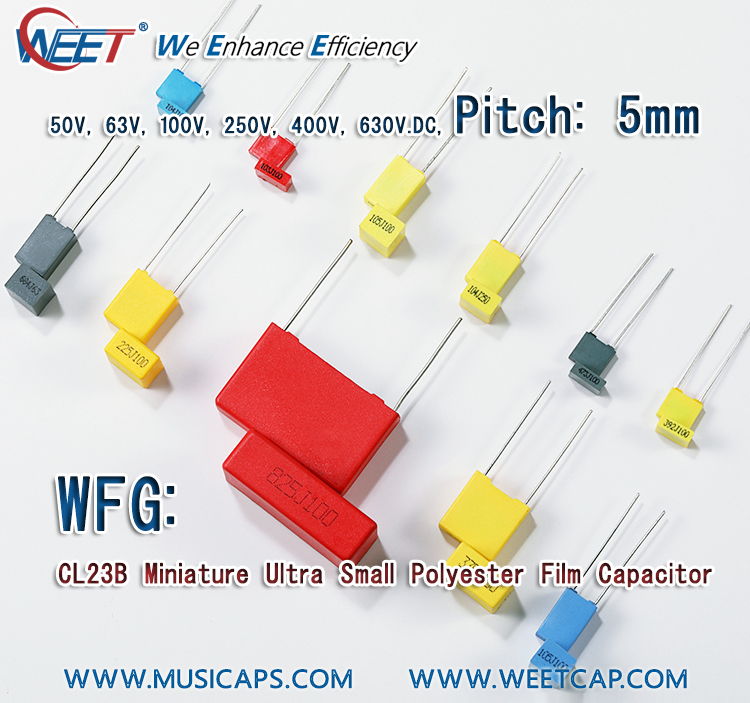
WEE Technology Company Limited - WEE are Capacitors Specialist
Sometimes, there may be many names for the same capacitor. Because of its many names, it is easy to confuse people. Is CL23B a correction capacitor?
In fact, there are many kinds of correction capacitors. For example, the winding type is called CL23B capacitor, and the other is CL71 capacitor with laminated structure. Even the correction capacitor is also called minibox capacitor, miniaturized boxed capacitor, ultra-small boxed capacitor, etc. in fact, they all refer to a kind of capacitor, that is, correction capacitor.
Small boxed film capacitors CL23B series use metallized polyethylene film as medium and electrode, non inductive structure, encapsulated in small plastic shell and filled with epoxy resin.
The capacitor has small volume and good appearance consistency. It is especially used in some circuit occasions requiring small capacitance volume. It is mostly used in all kinds of low-power and low-frequency circuits.
This kind of capacitor is encapsulated with plastic shell. The common colors are yellow, gray, red and blue. Although the colors are different, the performance is not much different, and the functions are the same.
| Operating Temperature: | -40℃~ +100℃ , 40/100/21 |
| Rated Voltage(V.DC): | 50V, 63V, 100V, 250V, 400V, 630V. |
| Capacitance Range: | 0.001 ~ 2.2µF |
| Capacitance Tolerance: | ±5%, ±10%, ±20% |
| Insulation Resistance: | UR≤100V C≤0.33µF ≥3750MΩ |
| C>0.33µF ≥1250S | |
| UR>100V C≤0.33µF ≥7500MΩ | |
| C>0.33µF ≥2500S | |
| (20℃ 100VDC 60SEC) P.S: T[s]=I.R.[MΩ]*CN [µF] | |
| Dissipation Factor: | ≤0.01 (at 1KHz 20℃) |
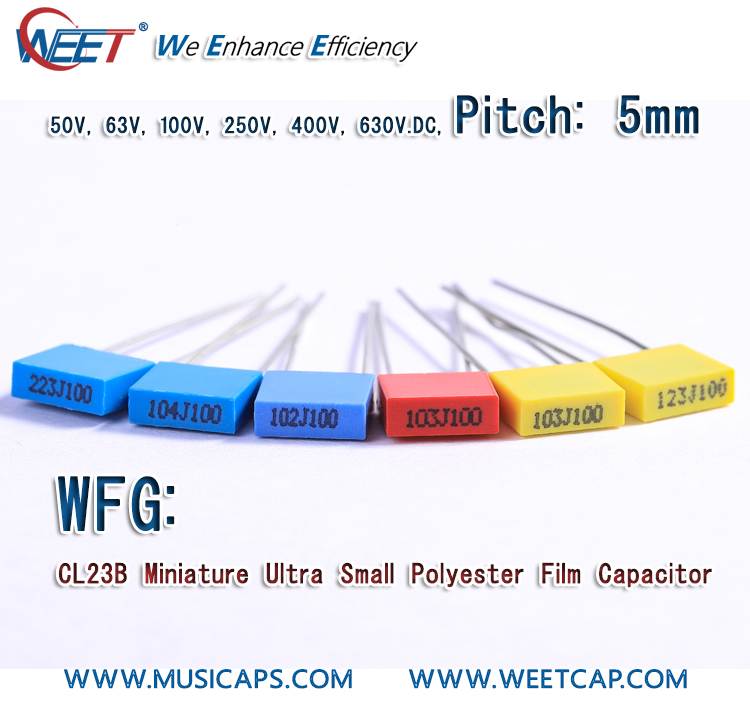
WEE Technology Company Limited - WEE are Capacitors Specialist
WEET WFG CL23B Mini Box Metallized Polyester Film Capacitor Features:
Miniature size, Rounded by metalized polyester film, good self-healing effect
Moisture-proof, flame retardant, some small capacitance can be used in series film
Low dissipation factor, high voltage, box type by the epoxy potting
Good self-healing effect, good stability and reliability
WEET WFG CL23B Mini Box Metallized Polyester Film Capacitor Main Applications:
Identical appearance is applicable to all kinds of low dissipation and high precision capacitance circuits
Widely used for DC low pulse portion of occasions, typical applications are amplifier, TV, communications, power supply and other products requiring high reliability circuit
WEET WFG CL23B Mini Box Metallized Polyester Film Capacitor Datasheet:
https://www.weetcap.com/pdf/WEET-WFG-Mini-Box-Metallized-Polyester-Film-Capacitors-CL23B.pdf
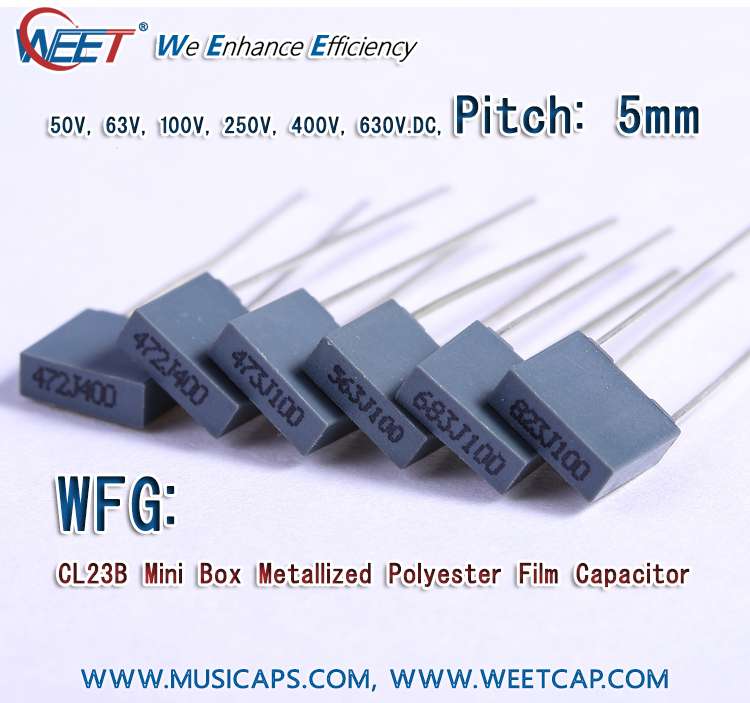
WEE Technology Company Limited - WEE are Capacitors Specialist
We are glad to inform you that WEET is capable of producing Polypropylene Film 1uF~100uF Audio capacitors, (5% tolerance for % general use), rated voltage at 50V to 100V.
Below is the detailed capacitance for your kind review. Thank you so much.
| WEET MKP Polypropylene Film Audio Capacitors, Low voltage, Low DF, Samll Size | |||||||
| Cap. | Spec. | Spec. | Size: L*OD mm | Cap. | Spec. | Spec. | Size: L*OD mm |
| 1.0uF | 1.0J50V | 1.0J100V | 24*9.5 | 9.1uF | 9.1J50V | 9.1J100V | 45*17 |
| 1.1uF | 1.1J50V | 1.1J100V | 24*10 | 10uF | 10.0J50V | 10.0J100V | 45*18 |
| 1.2uF | 1.2J50V | 1.2J100V | 24*10 | 11uF | 11.0J50V | 11.0J100V | 45*18.5 |
| 1.3uF | 1.3J50V | 1.3J100V | 24*10.5 | 12uF | 12.0J50V | 12.0J100V | 45*19.5 |
| 1.5uF | 1.5J50V | 1.5J100V | 24*11.5 | 13uF | 13.0J50V | 13.0J100V | 45*20.5 |
| 1.6uF | 1.6J50V | 1.6J100V | 24*11.5 | 14uF | 14.0J50V | 14.0J100V | 45*21 |
| 1.8uF | 1.8J50V | 1.8J100V | 24*12 | 15uF | 15.0J50V | 15.0J100V | 45*22 |
| 2uF | 2.0J50V | 2.0J100V | 30.5*10.5 | 16uF | 16.0J50V | 16.0J100V | 45*22.5 |
| 2.2uF | 2.2J50V | 2.2J100V | 30.5*11 | 18uF | 18.0J50V | 18.0J100V | 45*23.5 |
| 2.4uF | 2.4J50V | 2.4J100V | 30.5*11.5 | 20uF | 20.0J50V | 20.0J100V | 45*25 |
| 2.5uF | 2.5J50V | 2.5J100V | 30.5*12 | 22uF | 22.0J50V | 22.0J100V | 45*26.5 |
| 2.7uF | 2.7J50V | 2.7J100V | 30.5*12.5 | 24uF | 24.0J50V | 24.0J100V | 45*27 |
| 3uF | 3.0J50V | 3.0J100V | 30.5*13 | 25uF | 25.0J50V | 25.0J100V | 45*28 |
| 3.3uF | 3.3J50V | 3.3J100V | 30.5*13.5 | 26uF | 26.0J50V | 26.0J100V | 45*28.5 |
| 3.6uF | 3.6J50V | 3.6J100V | 30.5*13.5 | 27uF | 27.0J50V | 27.0J100V | 55*25.5 |
| 3.7uF | 3.7J50V | 3.7J100V | 30.5*13.5 | 30uF | 30.0J50V | 30.0J100V | 55*27 |
| 3.9uF | 3.9J50V | 3.9J100V | 30.5*14.5 | 33uF | 33.0J50V | 33.0J100V | 55*28 |
| 4uF | 4.0J50V | 4.0J100V | 30.5*14.5 | 35uF | 35.0J50V | 35.0J100V | 55*29.5 |
| 4.3uF | 4.3J50V | 4.3J100V | 30.5*15.5 | 36uF | 36.0J50V | 36.0J100V | 55*29.5 |
| 4.4uF | 4.4J50V | 4.4J100V | 30.5*14.5 | 39uF | 39.0J50V | 39.0J100V | 55*31 |
| 4.5uF | 4.5J50V | 4.5J100V | 30.5*15 | 40uF | 40.0J50V | 40.0J100V | 55*31.5 |
| 4.7uF | 4.7J50V | 4.7J100V | 30.5*16 | 47uF | 47.0J50V | 47.0J100V | 55*33 |
| 5uF | 5.0J50V | 5.0J100V | 30.5*16.5 | 50uF | 50.0J50V | 50.0J100V | 55*33.5 |
| 5.1uF | 5.1J50V | 5.1J100V | 30.5*16.5 | 51uF | 51.0J50V | 51.0J100V | 55*35 |
| 5.5uF | 5.5J50V | 5.5J100V | 30.5*16.5 | 56uF | 56.0J50V | 56.0J100V | 55*36 |
| 5.6uF | 5.6J50V | 5.6J100V | 30.5*17 | 62uF | 62.0J50V | 62.0J100V | 55*37 |
| 6.2uF | 6.2J50V | 6.2J100V | 30.5*17.5 | 68uF | 68.0J50V | 68.0J100V | 55*38.5 |
| 6.8uF | 6.8J50V | 6.8J100V | 30.5*19 | 75uF | 75.0J50V | 75.0J100V | 55*41 |
| 7.2uF | 7.2J50V | 7.2J100V | 30.5*19 | 82uF | 82.0J50V | 82.0J100V | 55*42 |
| 7.5uF | 7.5J50V | 7.5J100V | 30.5*19.5 | 91uF | 91.0J50V | 91.0J100V | 55*44.5 |
| 8uF | 8.0J50V | 8.0J100V | 30.5*21.5 | 100uF | 100.0J50V | 100.0J100V | 55*47 |
| 8.2uF | 8.2J50V | 8.2J100V | 45*16.5 | Other Capacitance Are Available on Request | |||
WEE Technology Company Limited - WEE are Capacitors Specialist
WEE Technology can produce and offer you full series of film capacitors under our own trademark WEET.
Different dielectric materials:polyester film capacitors, Box type polypropylene film capacitors, Dip type polypropylene film capacitors
Tolerance range:±1%, ±2%, ±2.5%, ±5%, ±10%
Temperature range:normally film capacitors temperature range is -40'C to 85'C, for some series we can provide a wide temperature range up to 125'C.
Technology available:Winding technology and stacked technology, single side metallized structure and metallized structure
Safety Approvals of film capacitors:RoHS REACH ENEC, VDE, UL, TUV, CE
Packaging:Ammo/Tape packaging and Bulk packaging both available
WEET All Kinds of Capacitors Cross Reference Guide
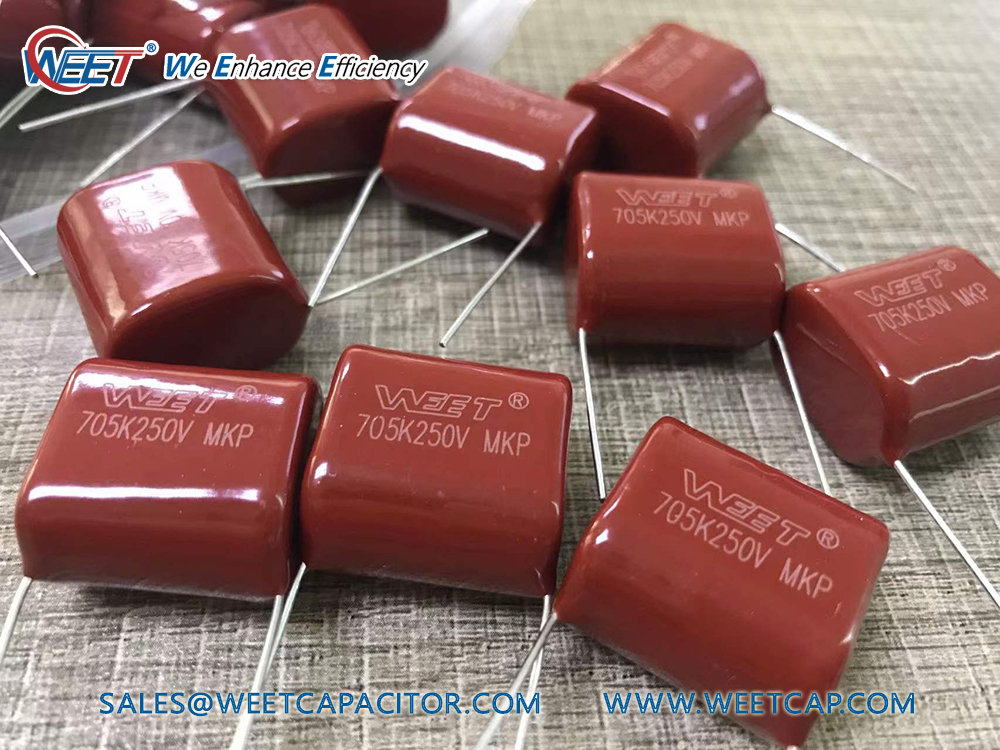
WEE Technology Company Limited - WEE are Capacitors Specialist
As an energy storage element, button supercapacitor is widely used in the backup power supply of instruments and clocks.
It has the characteristics of short charging time, long service life, good temperature characteristics, energy conservation and green environmental protection.
C. H-type and V-type structures can be selected during installation;
Product application: backup power supply, data protection and backup functions in electronic products with memory storage function.
Suitable for systems with CPU. Intelligent "three meters", tax controller, solar lamp, toy, solenoid valve, LED display screen, solar spike lamp, solar lawn lamp, industrial controller, on-board navigation equipment, remote control electric toys, electric vehicles, hybrid vehicles, car audio, electric tools, wind power generation, industrial UPS, peak power compensation, DC screen and other fields。
https://www.weetcap.com/pdf/WEET-WUA-5.5V-Coin-Type-Cell-Super-Capacitors.pdf
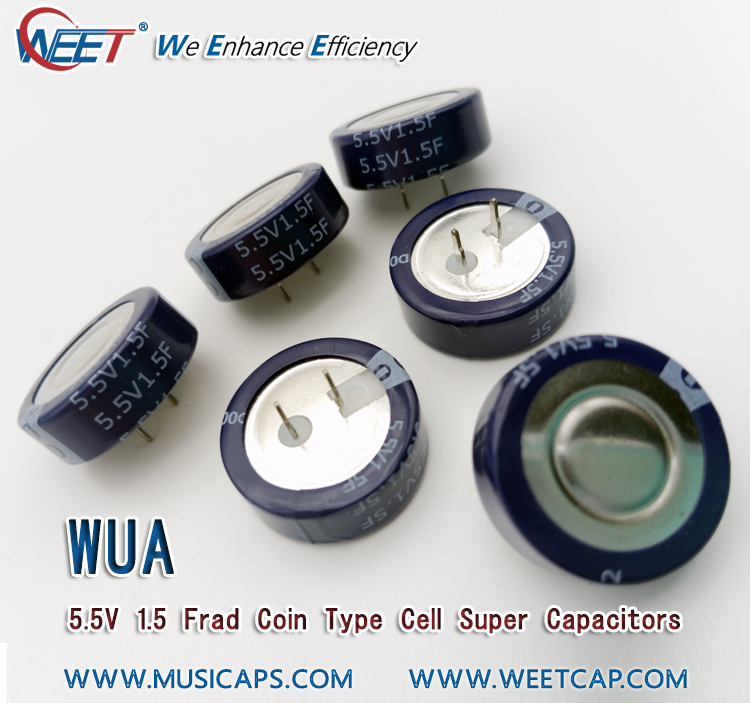
WEE Technology Company Limited - WEE are Capacitors Specialist
WEET Polyester and Polypropylene Film Capacitor RoHS REACH Halogen Test Report
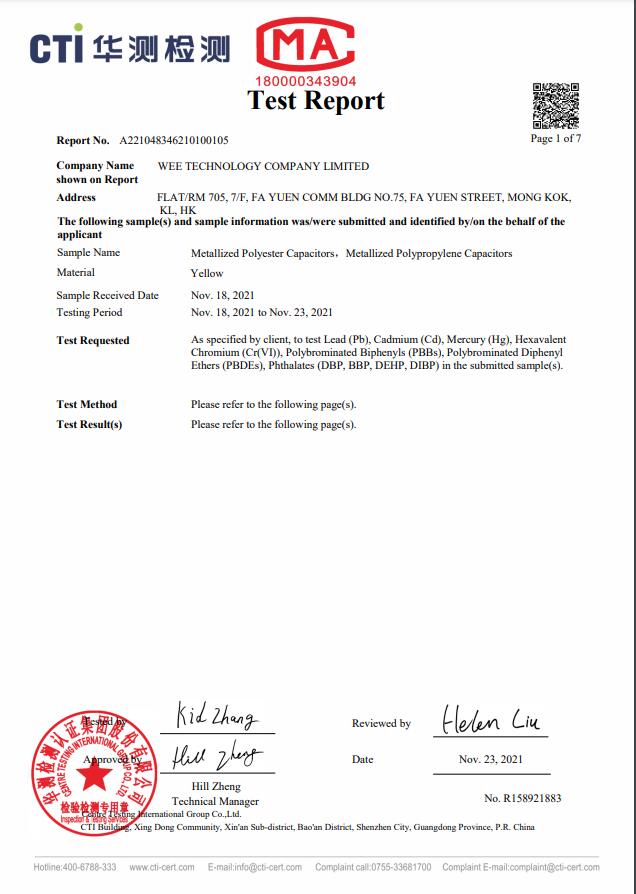
WEE Technology Company Limited - WEE are Capacitors Specialist
Dear customer,
We are here to inform you the holiday notice. All your enquires will be replied on 8th Feb.2022
For urgent matters, please call us at 0086 139 2570 0687
For general matters, please just send email to us as usual, we will try to reply you ASAP
WEET wish you good luck, good health, great sucess and good cheer in the near year of Tiger 2022
Chinese Traditional Spring Festival Period: 22nd Jan. 2022 to 7th Feb.2022, resume work on 8th Feb.2022

